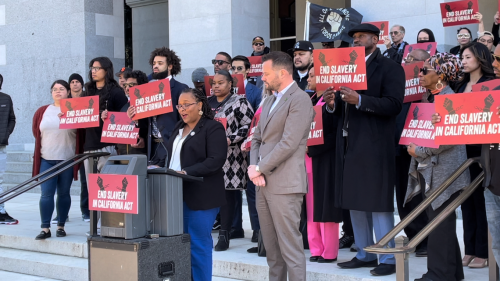

![]()
By Gibran Khalil
SACRAMENTO, CA – Lawmakers in California, as well as Nevada, are seeking to remove “involuntary servitude” from their state constitutions, with the goal of “removing exceptions from state constitutions that allow forced labor as criminal punishment.” Assemblymember Lori D. Wilson, who wrote the measure, said despite doubts on whether meaningful change could be initiated by such a proposal, it’s important to first start with amending the state constitution as “there is no room for slavery in our Constitution. It is not consistent with our values, nor our humanity.”
In the fall of 2022, Alabama, Oregon, Tennessee, and Vermont approved of similar ballot measures. According to the Abolish Slavery National Network, more states are pushing this year to also get rid of the involuntary servitude exceptions. The “exception” refers to the 13th Amendment and its different versions that exist in states like California that prohibits the use of slavery and involuntary servitude “except as punishment for crime.” Ava DuVernay’s 2016 film 13th exposes the nature of the racialized criminal justice system and its use of prison labor, from the history of its rise to its existence today. Both the film and advocates of the bill proposed in California and other states agree that involuntary servitude simply describes a condition of slavery for prisoners.
In fact, prisoners in California and other states are paid $1 an hour or less, with an average hourly rate of 13 to 52 cents, to fight fires, clean prison cells, make license plates, or do yard work at cemeteries and other jobs. Incarcerated workers are not protected by any labor laws, and are often forced into unsafe conditions with little to no training. This can pose an extreme risk to their health, which Covid-19 has only exacerbated. As further reported by the ACLU, there is even discrimination within the incarcerated workplaces, where jobs can be designated based on race within the prison.
Over the summer, a similar proposal to ban involuntary servitude in prisons failed to pass the state Senate. Governor Newsom and his administration cited concerns over impact within the state prison system in addition to claiming that taxpayers would be forced to pay $1.5 billion dollars per year to afford paying prisoners minimum wage. Despite this seemingly gaudy figure that could ostensibly ensure minimum compensation for the extracted prison labor. However, California taxpayers are still forced to shoulder the cost of over $20 billion to both police and sheriff’s departments alone. The state of California spends about $50 billion every year on local law enforcement, state prisons, and county jails. Not only does this represent an extreme tilt towards spending on police and prisons as opposed to other underfunded public services such as education and mental health resources, but, as the California Budget and Policy Center states, this effort also represents a clear, state-wide intention to continue the trend of overcriminalization within Black and Brown communities. Furthermore, such a discrepancy in the money needed to give prisoners minimum wage versus the money the state provides to maintain and expand the criminal legal system suggests there is more than enough funds available to provide such basic minimums to our communities behind bars.
It actually seems that reluctance to provide such basic minimums could stem from a state and national reliance on prison labor. As the ACLU reported in their report titled, “Captive Labor: Exploitation of Incarcerated Workers,” the state of California’s correctional industries programs led the nation in fiscal sales in the 2019 fiscal year. This means the state-level “correctional industries” programs in California, where workers are paid at those aforementioned extremely low wages, provided the highest level of sales of goods for the industries worked in at $249,961,931.
Furthermore, the federal government operates its own program called UNICOR, which is a United States government corporation employing 16,315 federally incarcerated people to produce goods and services. Manufacturing for various sectors can take place at extremely low labor costs due to the mass amount of workers being incarcerated, goods can then be sold at extreme profit to other private enterprises and purchasers. California, despite some shifts away from this work, is notorious for its use of incarcerated individuals for public services as well, such as fighting wildfires.
As the Prison Policy Initiative further reports, around 4,000 companies or more profit from mass incarceration, and the average earnings one person loses over their lifetime due to being incarcerated is around $500,000. Private companies; state, local, and federal governments; and public and private prisons all benefit highly from a system that profits off the labor of incarcerated individuals who are given abysmal rates of pay, showing the system’s instrumentality in maximizing profit for those involved. States can be so heavily reliant on such a model of exploitation that even their politicians, such as in Arizona, admit the state would collapse without the use of prison labor.
California, and the nation’s, continued reliance on incarceration for profit shows how the United States has only adapted systems of slavery and carcerality, instead of abolishing them. This has ultimately allowed for our “justice” systems to penalize along racialized lines and deeply harm our communities of color, while exercising control over these communities to gain profit for owners and shareholders. We must examine our nation’s history if we are to confront our current reality, in a concentrated effort to make our communities safer, more equitable, and free.
Gibran is a senior at UC Berkeley studying Political Science and Ethnic Studies. He is originally from the Los Angeles area, and enjoys watching and playing soccer, listening to music, and discovering new food spots in his free time.